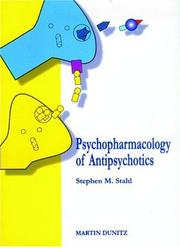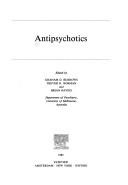| Listing 1 - 10 of 83 | << page >> |
Sort by
|

ISBN: 185317601X 1853177636 Year: 1999 Publisher: London : Martin Dunitz,
Abstract | Keywords | Export | Availability | Bookmark
 Loading...
Loading...Choose an application
- Reference Manager
- EndNote
- RefWorks (Direct export to RefWorks)
Book
Year: 2009 Publisher: Oslo, Norway : Knowledge Centre for the Health Services at The Norwegian Institute of Public Health (NIPH),
Abstract | Keywords | Export | Availability | Bookmark
 Loading...
Loading...Choose an application
- Reference Manager
- EndNote
- RefWorks (Direct export to RefWorks)
Background The Norwegian Medicines Agency asked the Norwegian Knowledge Centre for the Health Services to review the documentation for antipsychotic drugs in order to evaluate differences in efficacy and safety between the various drugs used for schizophrenia in adults. Methods We searched systematically for literature in the Cochrane Library, Medline, Embase and PsychInfo. We evaluated all identified reviews according to predefined inclusion criteria and appraised the methodological quality of the included systematic reviews. Results We included six systematic reviews. We extracted and analyzed results on the efficacy or safety of first generation antipsychotics (typical antipsychotics) versus second generation antipsychotics (atypical antipsychotics) and among the various second generation antipsychotics. Of 99 possible comparisions, data were available on only 30. We found few differences in efficacy. However, haloperidole showed less efficacy than amisulpride and clozapine, and olanzapine led to greater improvement in functional capacity than quetiapine and ziprasidone. With respect to efficacy measured as symptom response among the second generation antipsychotics there were no differences. For adverse events, metabolic adverse events were most obvious for the second-generation antipsychotic drug olanzapine followed by clozapine and quetiapine, and extrapyramidal adverse events were most obvious for the first- generation antipsychotic drugs haloperidole and perfenazine. There were no differences in extrapyramidal symptoms among the second generation antipsychotics, except that quetiapin caused extrapyramidal symptoms in a greater proportion of patients than risperidon. There were no or few differences between the groups regarding cardiovascular, anticholinergic and hormonal adverse events as well as for discontinuation. Conclusion We found few differences in efficacy between first- and second- generation antipsychotic drugs, and among the second generation antipsychotics. For adverse events there were reported differences for at least one type of adverse event for the majority of the comparisons.
Book
Year: 2007 Publisher: Rockville, MD : Agency for Healthcare Research and Quality (US),
Abstract | Keywords | Export | Availability | Bookmark
 Loading...
Loading...Choose an application
- Reference Manager
- EndNote
- RefWorks (Direct export to RefWorks)
Dissertation
Year: 1967 Publisher: Université de Liège. Faculté de Médecine,
Abstract | Keywords | Export | Availability | Bookmark
 Loading...
Loading...Choose an application
- Reference Manager
- EndNote
- RefWorks (Direct export to RefWorks)
Book
Year: 2009 Publisher: Oslo, Norway : Knowledge Centre for the Health Services at The Norwegian Institute of Public Health (NIPH),
Abstract | Keywords | Export | Availability | Bookmark
 Loading...
Loading...Choose an application
- Reference Manager
- EndNote
- RefWorks (Direct export to RefWorks)
Background The Norwegian Medicines Agency asked the Norwegian Knowledge Centre for the Health Services to review the documentation for antipsychotic drugs in order to evaluate differences in efficacy and safety between the various drugs used for schizophrenia in adults. Methods We searched systematically for literature in the Cochrane Library, Medline, Embase and PsychInfo. We evaluated all identified reviews according to predefined inclusion criteria and appraised the methodological quality of the included systematic reviews. Results We included six systematic reviews. We extracted and analyzed results on the efficacy or safety of first generation antipsychotics (typical antipsychotics) versus second generation antipsychotics (atypical antipsychotics) and among the various second generation antipsychotics. Of 99 possible comparisions, data were available on only 30. We found few differences in efficacy. However, haloperidole showed less efficacy than amisulpride and clozapine, and olanzapine led to greater improvement in functional capacity than quetiapine and ziprasidone. With respect to efficacy measured as symptom response among the second generation antipsychotics there were no differences. For adverse events, metabolic adverse events were most obvious for the second-generation antipsychotic drug olanzapine followed by clozapine and quetiapine, and extrapyramidal adverse events were most obvious for the first- generation antipsychotic drugs haloperidole and perfenazine. There were no differences in extrapyramidal symptoms among the second generation antipsychotics, except that quetiapin caused extrapyramidal symptoms in a greater proportion of patients than risperidon. There were no or few differences between the groups regarding cardiovascular, anticholinergic and hormonal adverse events as well as for discontinuation. Conclusion We found few differences in efficacy between first- and second- generation antipsychotic drugs, and among the second generation antipsychotics. For adverse events there were reported differences for at least one type of adverse event for the majority of the comparisons.
Book
Year: 2007 Publisher: Rockville, MD : Agency for Healthcare Research and Quality (US),
Abstract | Keywords | Export | Availability | Bookmark
 Loading...
Loading...Choose an application
- Reference Manager
- EndNote
- RefWorks (Direct export to RefWorks)
Book
Year: 2013 Publisher: Bruxelles: UCL. Faculté de pharmacie et des sciences biomédicales,
Abstract | Keywords | Export | Availability | Bookmark
 Loading...
Loading...Choose an application
- Reference Manager
- EndNote
- RefWorks (Direct export to RefWorks)
Le profil agoniste partiel de l'aripiprazole sur les récepteurs dopaminergique a en premier lieu été démontré sur un modèle cellulaire en mesurant l'accumulation d'AMPc. Cependant, sur le tissu le profil agoniste partiel de cette substance n'a toujours pas pu être confirmé malgré les nombreux essais biochimiques et les variations de conditions expérimentales. Il est suggéré que la réponse fonctionnelle de l'aripiprazole dépend fortement de l'environnement expérimental.En se basant sur cette hypothèse, nous avons choisi d'étudier l'influence des substances hétérologues sur la réponse dopaminergique sur des membranes de striatum de rats. En effet, il y a de plus en plus d'évidence que certaines substances endogènes telles que les substances adénosinergiques, glutamatergiques et cannabinoïdes ont un impact sur de nombreuses pathologies telles que la schizophrénie et la maladie de Parkinson. Notre hypothèse de travail est que les substances non dopaminergiques pourraient modifier laréponse fonctionnelle des ligands dopaminergiques et pourraient avoir un impact sur le profil agoniste partiel de l'aripiprazole.Nos résultats montrent que les substances adénosinergiques sont capables de modifier la réponse fonctionnelle des ligands dopaminergiques mais celles-ci sont aussi capables de révéler le profil agoniste partiel de l'aripiprazole. Nous insistons encore une fois sur le fait que le profil pharmacodynamique de l'aripiprazole peut être affecté par des modifications de l'environnement cellulaire tels que une co-incubation ou un prétraitement avec des substances non dopaminergiques. Ces résultats révèlent l'importance thérapeutique à cibler des voies non dopaminergiques pour moduler la réponse des antipsychotiques. The partial agonist profile of the novel antipsychotic aripiprazole at D2 receptors was first demonstrated in cellular models by measuring cAMP accumulation. However, on animal tissues, several biochemical assays and experimental conditions failed to unravel the partial agonist profile of aripiprazole. lt was suggested that the functional response to aripiprazole was highly dependent on the experimental paradigm . Herein, the influence of heterologous substances on dopaminergic response was examined on rat brain membranes. Indeed, increased evidences suggest that endogenous compounds such as serotonin, adenosine and glutamate may have an impact in numerous dopaminergic diseases, such as schizophrenia and Parkinson's disease. Our working hypothesis is that non dopaminergic compounds may modify the functional response to dopamine ligands and have an impact on the partial agonist profile of aripiprazole. Our results show that some non-dopaminergic substances are able to unravel the partial agonist profile of aripiprazole in a concentration-dependent manner. In contrast, those substances do not modify the response to either dopamine or (-)-3PPP (a low efficacy partial agonist). Our data suggest that the partial agonist profile of aripiprazole can be evidenced ex vivo on rat brain membranes. Moreover, we have emphasized once again the particular pharmacodynamics profile of aripiprazole which can be affected by a modification of cellular environment such as co-incubation or a pretreatment with non-dopaminergic compounds. These data highlight the importance of therapeutically targeting non dopaminergic pathways in order to modulate the responses to antipsychotic. More generally, heightened attention should be given to drug interactions especially with compounds showing complex functional profile like aripiprazole.
aripiprazole --- Antipsychotic Agents --- Antipsychotic Agents
Book
ISBN: 3805556543 9783805556545 Year: 1993 Publisher: Basel : Karger,
Abstract | Keywords | Export | Availability | Bookmark
 Loading...
Loading...Choose an application
- Reference Manager
- EndNote
- RefWorks (Direct export to RefWorks)
Antipsychotic Agents --- Antipsychotic drugs --- Antipsychotic drugs. --- Antipsychotische geneesmiddelen. --- Sedativa. --- Pharmacology.
Book
Year: 2015 Publisher: Bruxelles: UCL. Faculté de pharmacie et des sciences biomédicales,
Abstract | Keywords | Export | Availability | Bookmark
 Loading...
Loading...Choose an application
- Reference Manager
- EndNote
- RefWorks (Direct export to RefWorks)
La prise de poids induite par les antipsychotiques a un impact clinique majeur. Elle contribue à diminuer l'espérance de vie des patients sous médication antipsychotique et aggrave leur état pathologique , comme ce mémoire le détaille. L'intérêt de prévenir sa survenu€1 est dès lors primordial. Les mécanismes pharmacologiques responsables trouvent leur origine dans l'action antagoniste des antipsychotiques sur les récepteurs 5-HT2C de la sérétonine et Hl de l'histamine, principalement. Cette action peut différer fortement d'un individu à l'autre.La pharmacogénom ique a permis ces dernières années de faire des avancées considérables en la matière. Dans ce mémoire, sont tout particulièrement analysés les résultats de plusieurs études examinant l'effet des polymorphismes génétiques rs3813929 et rs518 147 du gène HTR2C codant pour le récepteur 5-HT2C ainsi que les mécanismes moléculaires sous-jacents. Antipsychotic-induced weight gain is a major clinical concern. It contributes to reduced life expectancy for patients taking antipsychotic drugs and worsens their condition, as investigated in this thesis. The interest of preventing its occurrence is therefore paramount. The pharmacological mechanisms are rooted in the antagonistic action of antipsychotic on 5-HTC2 and H1 receptors, mainly. This may differ greatly from one individual to another. In the recent years, pharmacogenomics has allowed to make significant progress in this area. In this submission, we analyses the results of several studies examining how weight gain may be influenced by genetic polymorphisms rs3813929 and rs518147 of HTR2C gene, which encodes for 5-HT2C receptor. We also review the underlying molecular mechanisms
Weight Gain --- Antipsychotic Agents --- Antipsychotic Agents

ISBN: 0444806350 Year: 1985 Publisher: Amsterdam Elsevier
Abstract | Keywords | Export | Availability | Bookmark
 Loading...
Loading...Choose an application
- Reference Manager
- EndNote
- RefWorks (Direct export to RefWorks)
Antipsychotic drugs --- Psychoses --- Antipsychotic Agents --- Chemotherapy --- pharmacology
| Listing 1 - 10 of 83 | << page >> |
Sort by
|

 Search
Search Feedback
Feedback About UniCat
About UniCat  Help
Help News
News